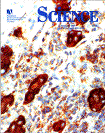

%Laboratory of Immunology, Endocrinology Section, Institute of Clinica Medica, University of Palermo, Italy. $, Department of Experimental Medicine and Biochemical Sciences, University of Rome "Tor Vergata", Italy. ^, Department of Immunobiology, Institute of Cell Biology, CNR, Rome, Italy. &, Allergology and Clinical Immunology, University of Genova, Italy.
#Contributed equally to this work
* Corresponding author: Roberto Testi
The mechanisms responsible for thyrocyte destruction in Hashimoto's thyroiditis (HT) are poorly understood. Thyrocytes from HT glands, but not from non autoimmune thyroids, expressed Fas. IL-1beta, abundantly produced in HT glands, induced Fas expression in normal thyrocytes, and crosslinking of Fas resulted in massive thyrocyte apoptosis. The ligand for Fas (FasL) was found constitutively expressed both in normal and HT thyrocytes and able to kill Fas-sensitive targets. Exposure to IL-1 beta induced thyrocyte apoptosis which was prevented by antibodies that block Fas, suggesting that IL-1beta-induced Fas expression acts as a limiting factor for thyrocyte destruction. Thus, Fas-FasL interactions among HT thyrocytes may contribute to clinical hypothyroidism.